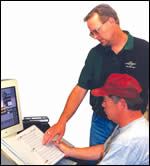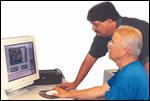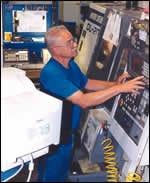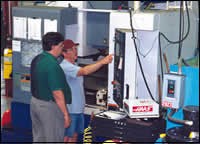Training By The Numbers
A formal training program not only helped ease this firm’s transition from cam automatics to CNC lathes, but it also enabled the firm to staff a third shift in record time.
Share



.png;maxWidth=45)
DMG MORI - Cincinnati
Featured Content
View More
Takumi USA
Featured Content
View More





Autodesk, Inc.
Featured Content
View More
Hwacheon Machinery America, Inc.
Featured Content
View MoreFor many people in metalworking, the term training evokes a Norman Rockwell-type image of a white-haired old timer showing a young, somewhat attentive apprentice how to run a machine on the production floor. If you are a machine operator, you probably received your training on the job working under the watchful eye of an experienced operator.
That kind of training may have been adequate a generation or two ago. However, as machine tools have become more sophisticated (and expensive) and as tolerance for errors of any kind in the machining process approaches zero, more formal training programs are becoming a more attractive training alternative for small shops as well as large manufacturing concerns. One reason is that they provide a more complete and comprehensive coverage of the material; the trainee benefits from a complete, well-thought-out program, presented and reinforced in ways that help him or her retain the information presented. Another reason is that formal training programs include tests that confirm whether or not the trainee is learning the material. Still another reason is that they provide an alternative to tying up operators and machines for basic training.
A formal training program became an important part of a long-term strategy for modernization and growth at Eaton Corp.’s Aeroquip Fluid Conveyance plant in Jackson, Michigan. The plant produces aerospace hoses and fittings for fuel lines, hydraulic lines and other applications. It supplies hoses, fittings and quick-disconnect couplings for military aircraft programs such as Lockheed Martin’s Joint Strike Fighter (JSF) and F-35 supersonic multi-role fighter, the U.S. Army’s new RAH-66 Comanche helicopter, Boeing’s C-17 cargo transport, and for commercial aircraft programs such as the Airbus A380.
The Aeroquip Fluid Conveyance plant includes a machining department that machines aerospace hose fittings from stainless steel (primarily), titanium and aluminum. It also has a fabricating department for welding and tube bending, and an assembly department where the machined fittings are added to the hoses and tubing.
Years ago, the plant machined the fittings on multi-spindle screw machines, for inventory. Lot sizes averaged about 500 pieces—much smaller than jobs usually run on multi-spindle machines. However, the machines provided the capacity for large jobs when needed, and the machining department was staffed by skilled and experienced multi-spindle screw machine operators and setup people who knew how to get the best from their machines. The system met the No. 1 goal of producing quality parts, for which management was willing to accept a little production inefficiency.
Eventually, however, the plant began to adopt lean manufacturing practices, and a decision was made to reduce finished product inventories. Lot sizes for machined fittings became smaller, necessitating more frequent setups, resulting in a situation where the multi-spindle machines were idle for setup changes more often than they ran. As lot sizes continued to shrink, the inefficiency of running the small jobs on multi-spindle screw machines could no longer be tolerated. Management began looking for a new machining strategy.
At the time, the plant had a small NC machining department built around two four-axis, CNC lathes made by Mori Seiki USA, Inc. (Richardson, Texas). The machines combined the ability to produce complex parts complete in one setup with more efficient production of small lot sizes, so the company made the decision to replace its multi-spindle cam machines with more four-axis CNC lathes. (Four chuckers would be retained for large jobs.)
Four Mori Seiki four-axis lathes were added to the two from the plant’s NC department. Randy Smith, senior manufacturing engineer for the machining department, explained the company’s selection of the Mori Seiki CNC lathes: “Our parts require a lot of machining on both ends,” he notes. “With most four-axis CNC lathes, the sub-spindle has less horsepower than the main spindle. Our lathes have the same horsepower on both spindles, permitting side two of the part to be machined in the secondary spindle at the same speeds and feeds as side one in the main spindle. Since most of our parts are stainless steel, and since that second side frequently needs as many operations as the first side, we need equal horsepower on both spindles.”
Assignment of jobs to the cells follows a family of parts arrangement by tooling rather than part geometry. “We started out trying to run very similar parts in a given cell—parts with the same configuration in a range of sizes—but the volume was not sufficient to justify the arrangement,” Mr. Smith explains. “Instead, we group parts according to the cutting tools they require, in order to reduce the setup time required to go from part to part.”
Average run size is about 175 parts—and getting smaller as the plant gets better at setup reduction and job scheduling. Some jobs involve runs as small as five parts. Setups average about 90 minutes, and operators spend about 180 minutes of their work day setting up for the next job. The setups usually include about three or four tool changes per turret.
Production continued on the multi-spindle screw machines as the CNC lathes were installed and brought online. By the end of the first year, however, production completely shifted over to the CNC lathes. “Within one week, we totally shut down production on the screw machines,” Mr. Smith recalls.
A Third Shift
At the same time that the plant was going from multi-spindle screw machines to CNC lathes, management decided to increase production in response to increased demand by starting up a third shift. That created a staffing problem. Historically, training at the Jackson facility consisted of one-on-one training with an experienced operator. The arrangement worked for the occasional new hire, but using it to train a shift’s worth of operators at the same time was out of the question. For one thing, there were more trainees than skilled operators. For another, training of so many new hires would tie up the operators and equipment and bring production to a halt. The situation called for a structured, more formal, training method that would permit training several people at the same time.
Eaton manufacturing engineers evaluated a training program available from MasterTask Training Systems (Rockford, Illinois), a division of V-TIP, Inc., and decided that it would meet the plant’s training needs. MasterTask is a multimedia training system that uses workbooks, videos, CD-ROMs and the Internet to train both new and experienced employees in machine tool operations, setups, programming and related topics. The company offers courses on CNC turning centers, machining centers, automatic screw machines, precision measurement for machinists, SPC and other manufacturing-related subjects.
Training proceeds from general principles to their application on specific machines. For example, in the Mastering CNC Lathes course, once a job task or CNC concept is introduced, the lesson shows how it is applied on machines equipped with the most common CNCs. This approach is designed to give trainees the understanding needed to operate any CNC lathe in the shop, regardless of the make of the control.
However, the supervisor can select the specific CNC that the trainee needs to learn when registering that person in the course. As a result, the trainee sees simulations of that control and is required to perform the job tasks using replicas of the screen display and control panel buttons during testing. Being able to select a specific control for training allows the trainee to make a mistake without damaging a machine or tying up production machinery during the learning process. It focuses the course on the type of control that the trainee will actually be using in production.
The Mastering CNC Lathes series includes five separate courses: The Basic CNC Lathe, Understanding Part Programs, Lathe Operator Skills, Basic Setup Skills and Advanced Setup Skills. Training materials for the series include 21 videocassette lessons, five CD-ROMs with 21 interactive tests, five instructor guides, five student guides and 21 lesson worksheets.
Perfect Score
MasterTask can be used for group or individual training and is designed to allow the trainee to learn at his or her own pace. An important feature of the system is that the trainee must master all of the information presented in each lesson before proceeding to the next. That’s where the testing comes in: The trainee must score 100 percent on each lesson quiz before advancing to the next lesson and must retest on the missed questions until everything is right. According to MasterTask, most trainees find it relatively easy to get perfect scores, and early successes encourage and motivate them to continue the learning process.
Group Training
For training purposes, the new hires for the third shift were divided into two groups for training on first and second shifts. The Mastering CNC Lathes material was presented to the two groups in an engineering department conference room made to double as a classroom. After going through the formal training program, the trainees then received hands-on training on the production floor with an experienced operator.
“The structured classroom presentations inspired us to follow suit with the on-the-job part of the training program,” adds John Walker, manufacturing supervisor for second shift and a member of the plant’s team for CNC training strategy. “Now, all trainers follow the same format. Our on-the-job training program includes how to use gages, setting up the machine, standard work practices on the machine and similar subjects. Before, if a trainee had to work with more than one trainer, it was easy to get confused because each trainer had his own style and his own ideas about what subjects were most important. Now we all follow the same format to ensure consistency and to make sure that every trainee receives the same information.”
Mr. Walker feels that MasterTask along with on-the-job training makes for a winning combination. “MasterTask gives the trainee a strong foundation,” he notes. “It provides the theory and background in NC that the trainee does not receive on the plant floor. It covers general and specific areas that might take a trainer a year to cover. It gives our trainees a general understanding of everything from tool positions to programming to edits . . . things that might take a trainer months to cover on a one-on-one basis.
“The on-the-job portion of the training program reinforces the formal training specific to our equipment, such as how to make offsets, how to change a collet, how to change a tool and so on,” he continues. “It’s all practical information that the trainee needs to operate a CNC lathe, but it doesn’t provide the CNC theory and background that the trainee receives in the formal training program.
“Also, we try hard to get our people to pay attention to their control screens during setups,” he continues. “They can stop their machines in time to prevent a crash if they understand what they’re looking at. That’s where MasterTask comes in handy. The course covers many different types of CNCs, so our new people benefit from training on simulations of controls that they’ll actually be working with.”
For Experienced Operators Too
In addition to bringing the new hires for the third shift up to speed quickly, the MasterTask training program also helped a number of the company’s experienced screw machine operators make the transition to CNC lathes. “We have a number of experienced operators going through the program,” Mr. Walker reports. “We thought that if there were any areas where the formal training program fell short of the mark, our 30-year people would spot them. In fact, one of our 30-year veterans just completed the program, and he really liked it.
“Many of our experienced operators asked to take the MasterTask training program even though they were not required to do so,” Mr. Walker continues. (The course is mandatory for all new operators.) “We have 14 operators on second shift, and all but one have taken the course.”
Operators take the course for 2 hours per day (on company time), 5 days per week, for 30 days. The training takes place away from the production area, in an office in the plant’s engineering area set aside for the purpose. Typically, the trainees go through the CD-ROM- and video-based materials without supervision unless they encounter a problem.
“When the trainee needs personal attention, we address the problem on a one-on-one basis,” Mr. Walker adds. “It’s important to help the trainee overcome the problem as soon as possible because he must take a quiz on each lesson, and unless he answers every question correctly he cannot move on to the next lesson. We help the trainees through their difficulties when needed to keep them motivated.”
Ron Schultz is one of the experienced operators who volunteered to go through the MasterTask program. “I was experienced with metal turning, having run screw machines and chuckers for over 25 years, but the Mori-Seiki four-axis lathes were a different way of cutting metal, and I felt that I had to learn the CNC machines,” he explains. “I took advantage of the training program offered by the company. Looking back on the experience, I missed some (test) questions and had to repeat a few things, but the program helped me a lot.”
When a trainee successfully completes the training program, he or she is called up in front of the 25-30 employees present at each shift-start meeting. The shift supervisor announces that the trainee has successfully completed the training program and presents a certificate to the trainee. The certificate is signed by MasterTask, the employee, the supervisor . . . it’s even registered on the Internet. “It’s an honor,” Mr. Walker stresses. “Everyone is proud to get that certificate.”
The most compelling reason for establishing the MasterTask training program at the plant was the need to train machine operators for the newly created third shift. Not only did the training program provide enough qualified operators to staff the third shift, but it provided them 2 months earlier than expected, enabling the shift to go into production ahead of schedule. Mr. Smith reports that 48 operators—both new hires and veteran operators—have successfully completed the training program to date. Results have been so successful that the plant has also added basic math and blueprint-reading courses to the curriculum.
Related Content
Finding Skilled Labor Through Partnerships and Benefits
To combat the skilled labor shortage, this Top Shops honoree turned to partnerships and unique benefits to attract talented workers.
Read MoreInside Machineosaurus: Unique Job Shop with Dinosaur-Named CNC Machines, Four-Day Workweek & High-Precision Machining
Take a tour of Machineosaurus, a Massachusetts machine shop where every CNC machine is named after a dinosaur!
Read MoreFinding the Right Tools for a Turning Shop
Xcelicut is a startup shop that has grown thanks to the right machines, cutting tools, grants and other resources.
Read MoreSolve Worker Shortages With ACE Workforce Development
The America’s Cutting Edge (ACE) program is addressing the current shortage in trained and available workers by offering no-cost online and in-person training opportunities in CNC machining and metrology.
Read MoreRead Next
Setting Up the Building Blocks for a Digital Factory
Woodward Inc. spent over a year developing an API to connect machines to its digital factory. Caron Engineering’s MiConnect has cut most of this process while also granting the shop greater access to machine information.
Read More5 Rules of Thumb for Buying CNC Machine Tools
Use these tips to carefully plan your machine tool purchases and to avoid regretting your decision later.
Read MoreRegistration Now Open for the Precision Machining Technology Show (PMTS) 2025
The precision machining industry’s premier event returns to Cleveland, OH, April 1-3.
Read More




















































